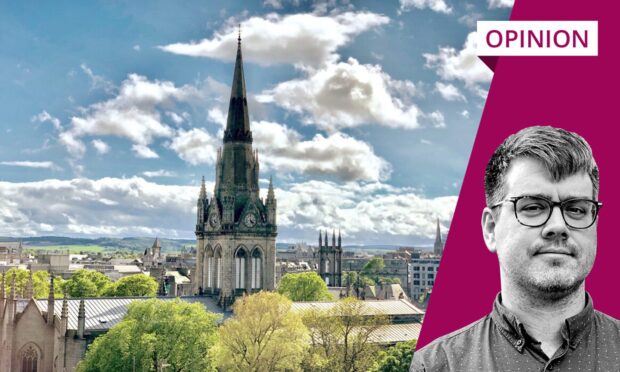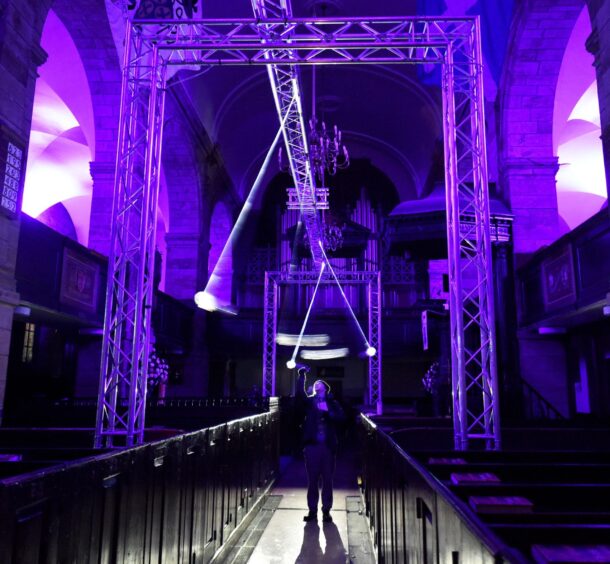If there’s anything I’ve long been an advocate for its new arts infrastructure in Aberdeen.
Anything we can do to extract more exhibition, performance and design space the better, in my humble opinion. Creative people play an important role in public life, and our urban space should give them all the canvas they need.
We have lost more than a few vital businesses in the city over the last few years, due to the cost of living and the pandemic, and of course not just limited to the arts. Belmont Cinema’s closure is the one that is closest to my heart, given my work history there.
St Nicholas Church as creative community space
It was therefore with delight that I read in February that Edinburgh Palette, now renamed Scot-Art, was seeking to purchase a wing of the mostly unused Church of St Nicholas, to turn it into a creative community space, right in the heart of Aberdeen.
They’ve been working in spaces in Edinburgh, primarily at St Margaret’s House in Meadowbank since 2008, where community-driven arts programmes have brought new life to an old unused office block. A music school, pottery, judo and yoga.
That is to name but a few of the activities now happening there.
St Nicholas Church sale complete
In Aberdeen, the purchase of St Nick’s is complete, with the keys being handed over to the new owners, by the Kirk, just last week.
We now await with bated breath to see how they transform the church and what role it might play in the regeneration of Union Street. What colour might it add to the city?
The only time I’ve been inside St Nicholas Church that I can recall was when it was previously taken over by an arts’ organisation.
I’m not hugely regular in my attendance between the hallowed pews, either in Aberdeen or anywhere else, but when Spectra stuck David Henckel’s mega ‘The Sun at Night’ in there in 2018 I couldn’t keep myself away, visiting three times.
Spaces changed, giving new life, and light, and drawing in those who may not usually dare to venture, or in my case, burst into flames.
Not only this but the Church, Robert Gordon’s College and Aberdeen City Council all retain interest in St Nick’s, along with Edinburgh Palette and The Open Space Trust, who own the other wing. Collaboration built in from the off.
It might seem an awkward fit for St Nicholas Church to be turned into artist studios
To some I’m sure it’ll be an awkward fit for a place of worship to be turned into artists’ studios or creative repositories but art and religion have always had a close bond.
The arts are contemplative and to an extent spiritual, and certainly contribute to a vast number of people’s health and wellbeing. You just have to balance accessibility and fun with the more contemplative side of the creative sector.
And arts organisations are long used to transforming old churches. When Belmont Cinema was Belmont Filmhouse our sister cinema in Edinburgh, Filmhouse, was based in an old Lothian Road church. Refitted and redesigned and turned into a very different kind of altar. It worked.
Could there be a Chaplain for Arts & Culture?
The Church of Scotland appoints a Chaplain to the Oil and Gas Industry, who is typically based in Aberdeen, being Scotland’s energy hub. One has to wonder if partnerships and purchases of the type that Scot-Art are pursuing, perhaps a Chaplain for Arts & Culture can be a thing of the future.
Scot-Art wants to open the church to the public ‘not through faith, but through community engagement’. The immediate area sorely needs it.
Already we’re starting to wonder how they might deal with some of the worse behaviour in the town centre and within the St Nicholas Kirkyard itself, where police and the city council have tried to adopt various strategies to deal with the issues over the last couple of years.
I do try to be positive about Union Street, but it would take blind faith to deny that there are social problems in the pockets and environs that badly need addressing.
Absence of people is a problem
Things have gotten worse, but my strong belief is the key problem remains the absence of usual foot traffic, which has made the anti-social behaviour all the more visible.
The best way to solve this – bring as many people back in as possible.
The likes of Edinburgh Palette, my own employer Outer Spaces, who also run studio spaces, and Aberdeen’s own vibrant cultural institutions working together to brighten back up the city is exactly what we need.
All the better if we can do this in venues and on stages which have been to some extent abandoned, bringing them back into use where they’ve lain still, filling them with joy, creativity and maybe even a little worship, again.
Colin Farquhar works as a creative spaces manager and film programmer in the north-east culture sector


Conversation